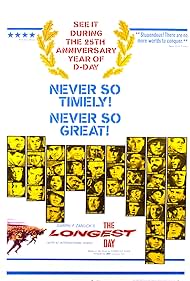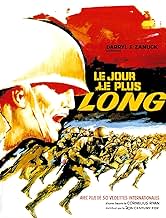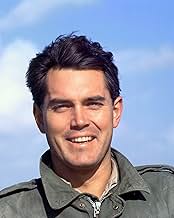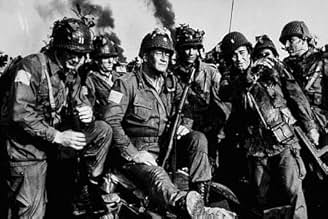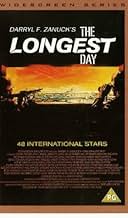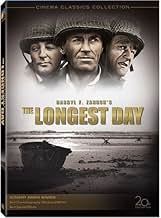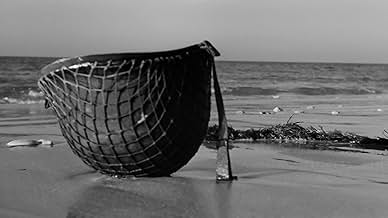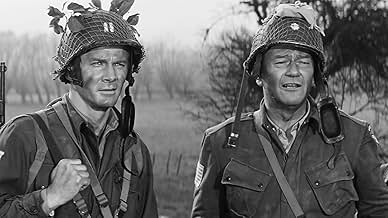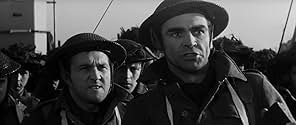The events of D-Day, told on a grand scale from both the Allied and German points of view.The events of D-Day, told on a grand scale from both the Allied and German points of view.The events of D-Day, told on a grand scale from both the Allied and German points of view.
- Won 2 Oscars
- 8 wins & 6 nominations total
Irina Demick
- Janine Boitard
- (as Irina Demich)
Featured reviews
Invariably compared with "Saving Private Ryan" (SPR), this scores over the more modern work because of the focus on all the major sides of the action (British, American, French and German).
All languages are used (with subtitles as appropriate - eg the Germans speak in German, etc).
While true that the battle scenes are not gory as SPR's, and that the sounds of battle are muted during the dialog (unlike SPR's), it should be borne in mind that in '62, the audience rating of the time *was* a General Release ("G" in the US, "A" in the UK (I'm guessing for the UK, but it is now PG)) - which more detail would not have allowed.
I think part of the purpose of this film is to allow *everyone* to see what happened 18 years before!
All languages are used (with subtitles as appropriate - eg the Germans speak in German, etc).
While true that the battle scenes are not gory as SPR's, and that the sounds of battle are muted during the dialog (unlike SPR's), it should be borne in mind that in '62, the audience rating of the time *was* a General Release ("G" in the US, "A" in the UK (I'm guessing for the UK, but it is now PG)) - which more detail would not have allowed.
I think part of the purpose of this film is to allow *everyone* to see what happened 18 years before!
This an important, interesting movie depicting the Overlord operation with monumental logistic and means of effecting the Normandy landing , the most difficult campaign of war . The picture brings to life the famous images of WWII and splendidly the most sensational military operation of the history in an Allied hard-fought effort . The film develops the previous days to the D-Day invasion , such as the landings and the advance over France . The film is magnificently produced in big budget by the great 20th Century Fox producer Darryl F. Zanuck . Evocative cinematography by Jean Bourgoun and catching song by Paul Anka with musical score by Maurice Jarre . Excellent casting by a great plethora of stars . Special mention for John Wayne as Lt. Colonel Benjamin Vandervoort , he's top-notch as a tough , valiant officer in this believable war film and terrific acting by Richard Todd as Major commanding Us paratroopers dropped to protect the flanks of the invasion and taking strategic bridge . Furthermore , known Generals and officers played by prestigious players , as Germans : General Gunther (Curt Jurgens) , Field Marshal Erwin Rommel (Hinz) , Field Marshal Von Rundstedt (Paul Hartmann), and Allied : Brig. General Theodore Roosevelt Jr (Henry Fonda) , Brig. General Norman Cota (Robert Mitchum) , General Haines (Mel Ferrer) , Brig. General James Gavin (Robert Ryan) , General Raymond Barton (Edmond O'Brien), Lt General OMar N Bradley (Stuart) , General Bernard L Montgomery (T. Reid) and General Dwight D. Eisenhower played by Henry Grace . Grace was a famed set designer , while he worked extensively for many films , his only appearance was an uncredited performance as Eisenhower ; despite not being an actor , he was cast for his uncanny resemblance to the General . This famous event from how was orchestrated the dangerous , risky landing maneuvers was professionally directed by a magnificent trio of directors , Ken Annakin , Bernhard Wicki and Andrew Marton.
Adding more details along with the well developed on the movie , the events that happened on June 6, 1944 were the following ones : Shortly after midnight on June 6, about 23.500 US and British paratroopers landed along the edges of the landing beaches . Their mission was to seize vital bridges and communications centers. They also had to hold off any Germans counterattacks until they were relieved by the amphibious forces. The Airbone landings were largely successful. Some US troops missed their target and end up scattered over the countryside. The main amphibious landings took place after an artillery bombardment from some 200 Allied warships at German positions also came under attack from Allied medium and heavy bombers. They were part of the 11,500 aircraft committed to D-Day. They bombed the Germans on and behind the five landing beaches. US troops landed on Utah beach. Strong currents and inaccurate navigation meant that they were a little away from their precise target. They landed about 1 mile (1,6 km) south. The beach there was relatively undefended. The troops soon knocked out the only concrete gun position guarding the beach.Demolitions teams cleared paths through the obstacles the beach and the first tanks crossed the Atlantic Wall. They fanned out into the countryside to link up with the paratroopers. By nightfall of D-Day some 23,000 men and 1,700 vehicles had gone ashore. The beach had been highly congested for much of the day. Utah was a triumph ,however Omaha beach was nearly a disaster, the fight was the most difficult. The Us troops were unable to get off the beach to make room for later waves of invaders. There were better defenses there than on the other beaches, and the German defenders were positioned on high ground, from where they could pour fire down on the attackers.The allies also made mistakes. The naval bombardment ended too soon, and the bombers missed their targets and launched landing crafts and amphibious tanks too far out from the beach, may were sunk. When the first assault wave landed ,it faced a bar-rage of fire , some men were thinking of evacuation. However small groups began to make it off the beach to the high ground beyond. By dusk, some men were ashore, most were still crowed on the beach. The high ground beyond was only thinly held by exhausted survivors waves. Some 2300 US troops had been killed in the landings. The operation had come close to disaster. The three Anglo-Canadian beaches-Gold, Sword and Juno stretched fore some 25 miles. They were wide and open and ideal for amphibious landings. The British on Gold and Sword quickly crashed though the Atlantic wall. Their success was due partly to a range of specially developed armored vehicles known as Funnies. The Canadians at Juno had a tougher time. They faced rough seas and alert defenders .By late morning ,they were also pushing inland. Despite the horror of beaches , overall Allied losses were far lower than expected. Some 6000 US personnel were killed, wounded, or missing, along with 4300 British and Canadian troops. German losses totaled between 4000 and 8000. By the day's end ,some 128000 Allied soldiers were ashore and many more were on their way.
Adding more details along with the well developed on the movie , the events that happened on June 6, 1944 were the following ones : Shortly after midnight on June 6, about 23.500 US and British paratroopers landed along the edges of the landing beaches . Their mission was to seize vital bridges and communications centers. They also had to hold off any Germans counterattacks until they were relieved by the amphibious forces. The Airbone landings were largely successful. Some US troops missed their target and end up scattered over the countryside. The main amphibious landings took place after an artillery bombardment from some 200 Allied warships at German positions also came under attack from Allied medium and heavy bombers. They were part of the 11,500 aircraft committed to D-Day. They bombed the Germans on and behind the five landing beaches. US troops landed on Utah beach. Strong currents and inaccurate navigation meant that they were a little away from their precise target. They landed about 1 mile (1,6 km) south. The beach there was relatively undefended. The troops soon knocked out the only concrete gun position guarding the beach.Demolitions teams cleared paths through the obstacles the beach and the first tanks crossed the Atlantic Wall. They fanned out into the countryside to link up with the paratroopers. By nightfall of D-Day some 23,000 men and 1,700 vehicles had gone ashore. The beach had been highly congested for much of the day. Utah was a triumph ,however Omaha beach was nearly a disaster, the fight was the most difficult. The Us troops were unable to get off the beach to make room for later waves of invaders. There were better defenses there than on the other beaches, and the German defenders were positioned on high ground, from where they could pour fire down on the attackers.The allies also made mistakes. The naval bombardment ended too soon, and the bombers missed their targets and launched landing crafts and amphibious tanks too far out from the beach, may were sunk. When the first assault wave landed ,it faced a bar-rage of fire , some men were thinking of evacuation. However small groups began to make it off the beach to the high ground beyond. By dusk, some men were ashore, most were still crowed on the beach. The high ground beyond was only thinly held by exhausted survivors waves. Some 2300 US troops had been killed in the landings. The operation had come close to disaster. The three Anglo-Canadian beaches-Gold, Sword and Juno stretched fore some 25 miles. They were wide and open and ideal for amphibious landings. The British on Gold and Sword quickly crashed though the Atlantic wall. Their success was due partly to a range of specially developed armored vehicles known as Funnies. The Canadians at Juno had a tougher time. They faced rough seas and alert defenders .By late morning ,they were also pushing inland. Despite the horror of beaches , overall Allied losses were far lower than expected. Some 6000 US personnel were killed, wounded, or missing, along with 4300 British and Canadian troops. German losses totaled between 4000 and 8000. By the day's end ,some 128000 Allied soldiers were ashore and many more were on their way.
This was an another one of these all-star casts that you don't see in more modern times, in which about everyone who was actor made an appearance....or it just seems that way. For those unfamiliar with this film, take a look back on the main page here and check out the famous names in this movie. Click the "more" under the cast overview and you'll see all the names. It's unbelievable. Some of them, to be fair, had very short roles in here, such as Henry Fonda, Rod Steiger and Roddy McDowell, but this is a real "Who's Who" of the acting profession in 1962. There are also a lot of German actors in here speaking German (with subtitles provided), perhaps numbering even more than the English-speaking stars. That's because the famous day of June 6, 1944, is seen from both sides of the conflict.
At three hours, it gives you plenty of D-Day World War II action. Almost two-thirds of the movie involves action from that famous invasion. In some spots, it just gets to be too much. Frankly, the whole film is too much and almost bogs down in too many areas....and it shouldn't, but it is a very technical film. And, for a film 45 years old, the action is pretty realistic. I thought the best shots were the overheads during one particular scenes when the Alies were going through a town.
I am anything but a WWII expert so how much detail of the infamous 'D-Day" here is correct, Since they went into such detail, I'll assume they were fairly accurate. I can't say but this movie educated me on the size of the task. I had no idea "D-Day" was this huge in scope: three million men and 5,000 ships??!!! Amazing.
At three hours, it gives you plenty of D-Day World War II action. Almost two-thirds of the movie involves action from that famous invasion. In some spots, it just gets to be too much. Frankly, the whole film is too much and almost bogs down in too many areas....and it shouldn't, but it is a very technical film. And, for a film 45 years old, the action is pretty realistic. I thought the best shots were the overheads during one particular scenes when the Alies were going through a town.
I am anything but a WWII expert so how much detail of the infamous 'D-Day" here is correct, Since they went into such detail, I'll assume they were fairly accurate. I can't say but this movie educated me on the size of the task. I had no idea "D-Day" was this huge in scope: three million men and 5,000 ships??!!! Amazing.
The Longest Day works on several levels - the most obvious being the "don't blink or you might miss several" nature of the Star-Studded cast. Much of the cast works very well (Sean Connery's little comedy double act with Norman Rossington is an unexpected highlight). Some less so, and some is just downright tokenism - Rod Steiger getting all of 43 seconds on-screen for example. But overall, it's always a watchable movie - beautifully shot.
Some previous comment have surprised me, particularly the assertion that The Longest Day is, in any way, a "pro-war" film. I'm not sure if there *is* such a thing, but if there is then The LOngest Day certainly doesn't fall into this category - the scene of bewilderment between Richard Burton and Richard Beymer at the end about the confusion and directionlessness of war is the perfect example, ending with the memorable line "I wonder who won".
I'm also surprised that a European reviewer should have accused this film, of all world war II movies, of being American propoganda. I wonder how many other WWII films include both German and (almost unqiuely) French perspectives of the war to such an extent that almost half of the dialogue in them is in a language other than English. I find the German sequences in The Longest Day to be amongst the most interesting historically and dramatically.
The film is certainly as accurate as it's possible for a fictional movie to be - the list of advisors that it had working on it should prove that - including many people who are portrayed by actors in the movie itself. These include the characters played by Peter Lawford, Richard Todd and Kenneth More, along with several of the German field officers. Little touches that seem utterly out of place (like the nuns procession through the French village bringing a temporary ceasefire) are actually historically spot-on.
The final problem for the modern reviewer, of course, is the inevitable comparison between this film and Saving Private Ryan. But, as several other contributors have noted, SPR is not only the product of a different age with a different view of these events - historical as opposed to something which happened so recently that half of the audience are likely to have lived through them. But, ultimately, something usually forgotten about Operation Overlord is that Omaha Beach was merely one battle of a very long day indeed. Americans tend to focus on it because of the death toll, but the taking of Utah, Sword and Gold were just as important to the overall outcome. The Longest Day is a film about five beaches, many battles, and many men - some, as Richard Burton says, dead, some crippled and some lost. It is an anti-war film which proves that you can be anti-war and still celebrate and acknowledge heorism. The heroism of the young American and British troops, falling face-first into the salt water of the Normandy killing grounds. The incredible bravery of the Rangers who scaled the cliffs at Pointe du Luc on and, ultimately, meaningless mission. The heroism of the two Luftwaffe pilots commanded to face the invading armies alone, and who did so (another historically accurate point).
The Longest Day is a historic film about a historical event and it should be viewed as such.
9/10
Some previous comment have surprised me, particularly the assertion that The Longest Day is, in any way, a "pro-war" film. I'm not sure if there *is* such a thing, but if there is then The LOngest Day certainly doesn't fall into this category - the scene of bewilderment between Richard Burton and Richard Beymer at the end about the confusion and directionlessness of war is the perfect example, ending with the memorable line "I wonder who won".
I'm also surprised that a European reviewer should have accused this film, of all world war II movies, of being American propoganda. I wonder how many other WWII films include both German and (almost unqiuely) French perspectives of the war to such an extent that almost half of the dialogue in them is in a language other than English. I find the German sequences in The Longest Day to be amongst the most interesting historically and dramatically.
The film is certainly as accurate as it's possible for a fictional movie to be - the list of advisors that it had working on it should prove that - including many people who are portrayed by actors in the movie itself. These include the characters played by Peter Lawford, Richard Todd and Kenneth More, along with several of the German field officers. Little touches that seem utterly out of place (like the nuns procession through the French village bringing a temporary ceasefire) are actually historically spot-on.
The final problem for the modern reviewer, of course, is the inevitable comparison between this film and Saving Private Ryan. But, as several other contributors have noted, SPR is not only the product of a different age with a different view of these events - historical as opposed to something which happened so recently that half of the audience are likely to have lived through them. But, ultimately, something usually forgotten about Operation Overlord is that Omaha Beach was merely one battle of a very long day indeed. Americans tend to focus on it because of the death toll, but the taking of Utah, Sword and Gold were just as important to the overall outcome. The Longest Day is a film about five beaches, many battles, and many men - some, as Richard Burton says, dead, some crippled and some lost. It is an anti-war film which proves that you can be anti-war and still celebrate and acknowledge heorism. The heroism of the young American and British troops, falling face-first into the salt water of the Normandy killing grounds. The incredible bravery of the Rangers who scaled the cliffs at Pointe du Luc on and, ultimately, meaningless mission. The heroism of the two Luftwaffe pilots commanded to face the invading armies alone, and who did so (another historically accurate point).
The Longest Day is a historic film about a historical event and it should be viewed as such.
9/10
'The Longest Day' is perhaps the greatest dramatic record of one of the defining moments in world history. After the intimacy of 'Saving Private Ryan', many critics have accused it of being a 'sanitized' version of the Normandy Invasion, but it is a different kind of film, entirely! While Steven Speilberg's aim was to personalize the horror facing the first wave of troops to hit the beach, Producer Darryl F. Zanuck, a D-Day vet, himself, wanted to create a mosaic of the myriad of personalities, events, and experiences that shaped the day. It is a film that looks objectively at all the forces who fought this epic battle, wisely casting major stars of each country to portray actual and fictitious characters. This was a bold move at the time, as subtitles are used extensively, giving the film has a uniquely international flavor. This is not your usual war film with 'American actors doing funny accents'!
There are many standout performances; a few that deserve particular recognition are Richard Burton's war-weary RAF pilot, the last survivor of his original squadron; Dietmar Schönherr as one of the few remaining Luftwaffe pilots, faced with the impossible order of stopping the invasion with two airplanes; Jeffrey Hunter, a young sergeant who is 'Dear John'ed and faces the horrendous Omaha landing; a pre-James Bond Sean Connery as a cocky Irish infantryman; Red Buttons, as a paratrooper whose chute snags on a church tower, and is forced to view the carnage as Germans annihilate jumpers dropping into a French town square; and John Wayne (himself a war film icon), as Lieutenant Colonel Benjamin Vandervoort, the Airborne commander, who impatiently waits for the 'Go' order, then breaks his ankle jumping into Normandy.
Filled with drama, humor, and pathos, 'The Longest Day' works on many levels, and is never dull! Over forty years after its initial release, it's semi-documentary style still seems as fresh and engrossing as ever, and works equally well viewed by itself, or paired with 'Saving Private Ryan'.
It should be an essential part of your film library!
There are many standout performances; a few that deserve particular recognition are Richard Burton's war-weary RAF pilot, the last survivor of his original squadron; Dietmar Schönherr as one of the few remaining Luftwaffe pilots, faced with the impossible order of stopping the invasion with two airplanes; Jeffrey Hunter, a young sergeant who is 'Dear John'ed and faces the horrendous Omaha landing; a pre-James Bond Sean Connery as a cocky Irish infantryman; Red Buttons, as a paratrooper whose chute snags on a church tower, and is forced to view the carnage as Germans annihilate jumpers dropping into a French town square; and John Wayne (himself a war film icon), as Lieutenant Colonel Benjamin Vandervoort, the Airborne commander, who impatiently waits for the 'Go' order, then breaks his ankle jumping into Normandy.
Filled with drama, humor, and pathos, 'The Longest Day' works on many levels, and is never dull! Over forty years after its initial release, it's semi-documentary style still seems as fresh and engrossing as ever, and works equally well viewed by itself, or paired with 'Saving Private Ryan'.
It should be an essential part of your film library!
Storyline
Did you know
- TriviaWhile clearing a section of the Normandy beach near Pointe du Hoc, the crew unearthed a tank that had been buried in the sand since the original invasion. Mechanics cleaned it off, fixed it up and it was used in the movie as part of the British tank regiment.
- GoofsWhen the two men are on the rocking boat in the beginning, the straps on their helmets remain at a 90-degree angle to the car they're sitting in despite the boat's drastic rocking back on forth, showing that it was the camera, not the boat, wobbling.
- Quotes
Flight Officer David Campbell: The thing that's always worried me about being one of the few is the way we keep on getting fewer.
- Crazy creditsThere is a 20-second overture on a black screen, no 20th Century Fox logo (in spite of this being one of their most expensive productions), and a six-minute cold open before the title is displayed. Apart from the title, there are no credits at the beginning of the film. All cast and crew credits are at the end of the film.
- Alternate versionsSome video copies omits Jean Servais scenes as a Free French admiral making a short speech to his crew before the shore bombardments starts.
- ConnectionsEdited into All This and World War II (1976)
Details
- Release date
- Country of origin
- Official site
- Languages
- Also known as
- El día más largo del siglo
- Filming locations
- Sainte-Mère-Eglise, Manche, France(parachutists landing in the village)
- Production company
- See more company credits at IMDbPro
Box office
- Budget
- $10,000,000 (estimated)
- Runtime2 hours 58 minutes
- Color
- Black and White(original version)
- Black and White
- Aspect ratio
- 2.35 : 1
Contribute to this page
Suggest an edit or add missing content

